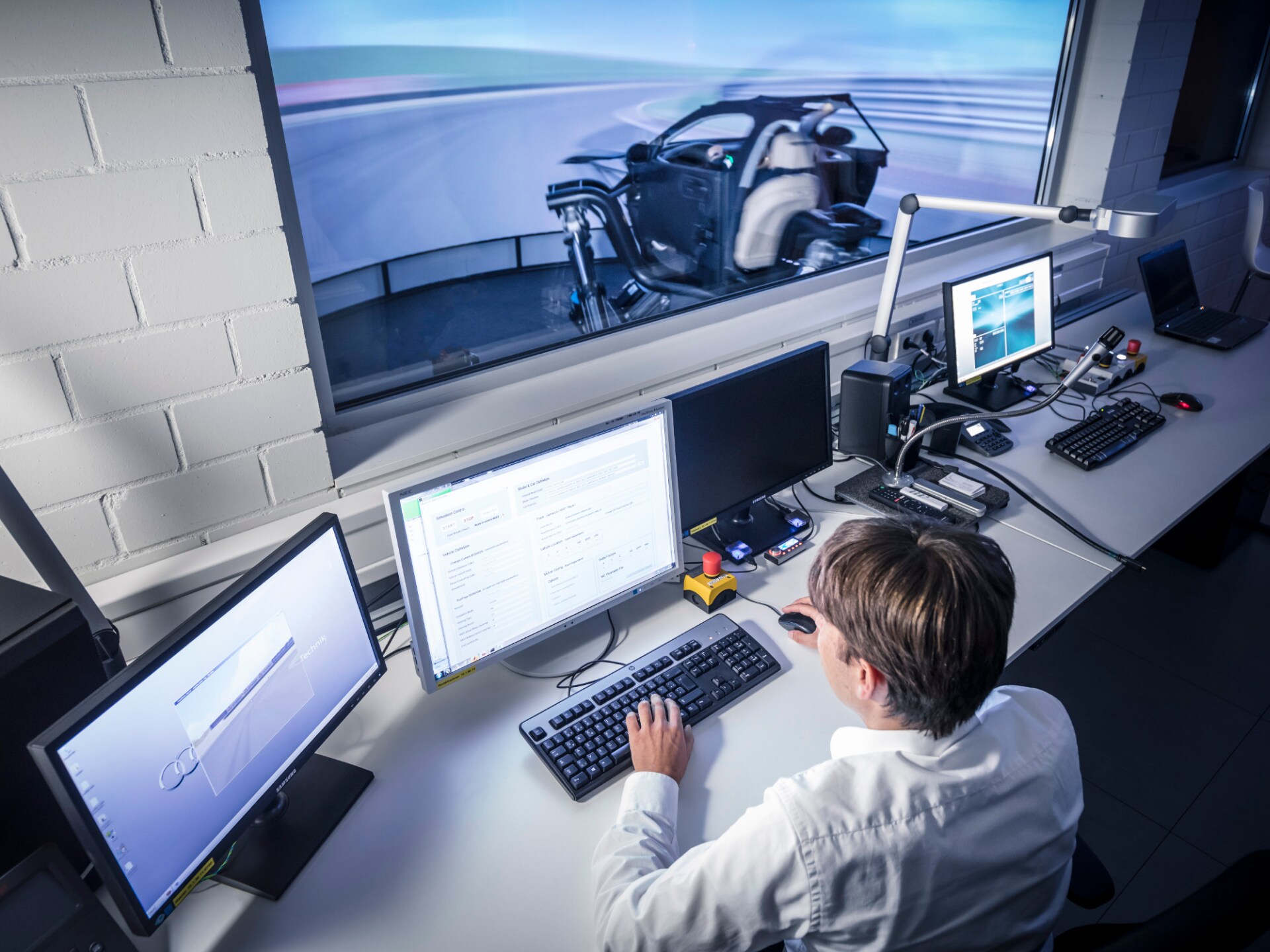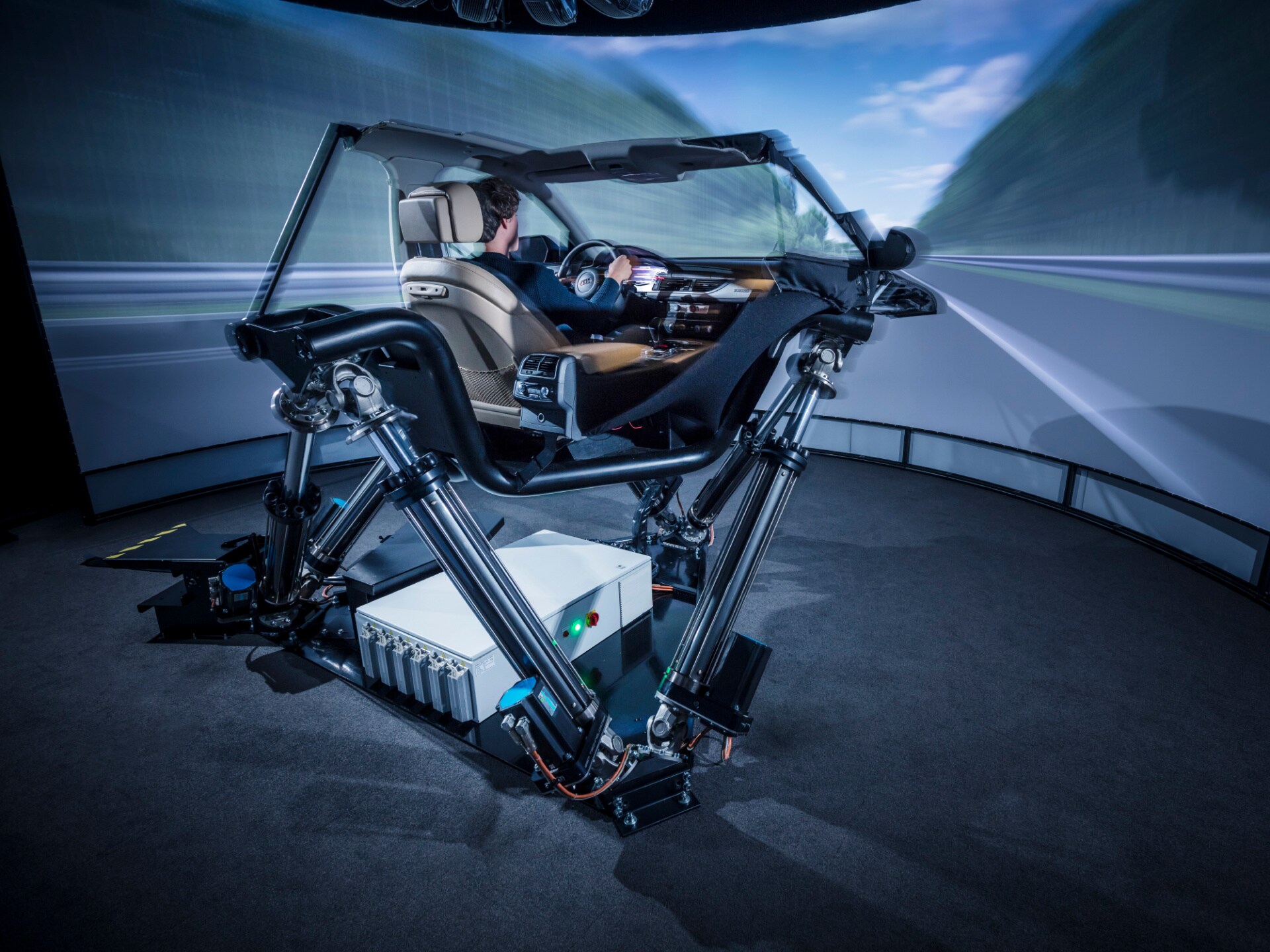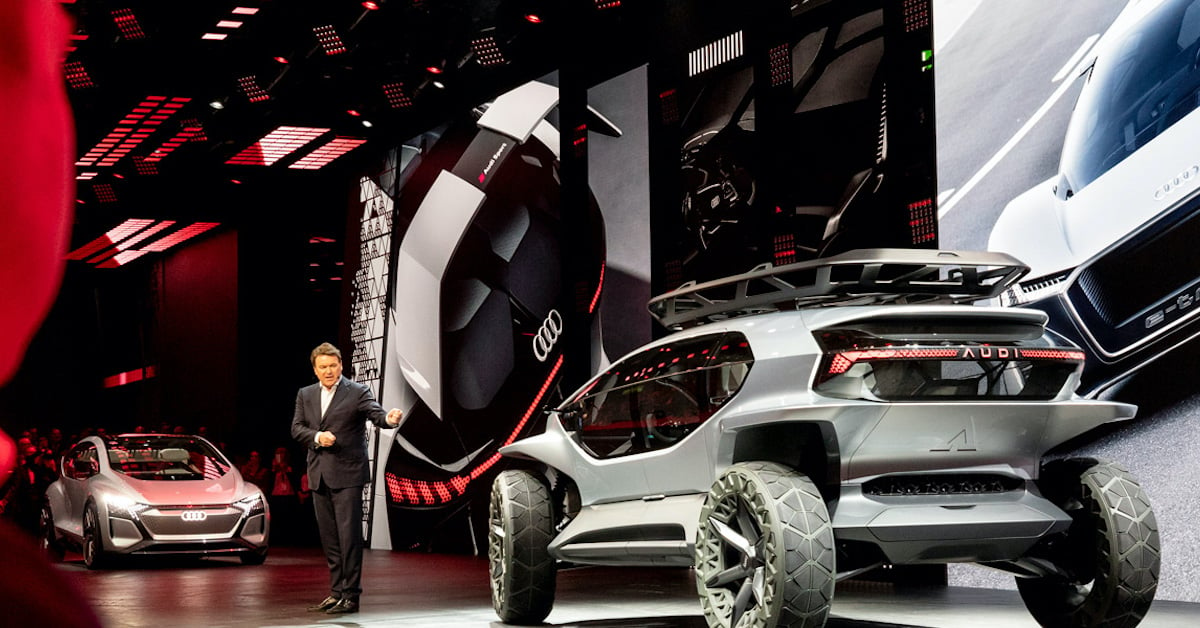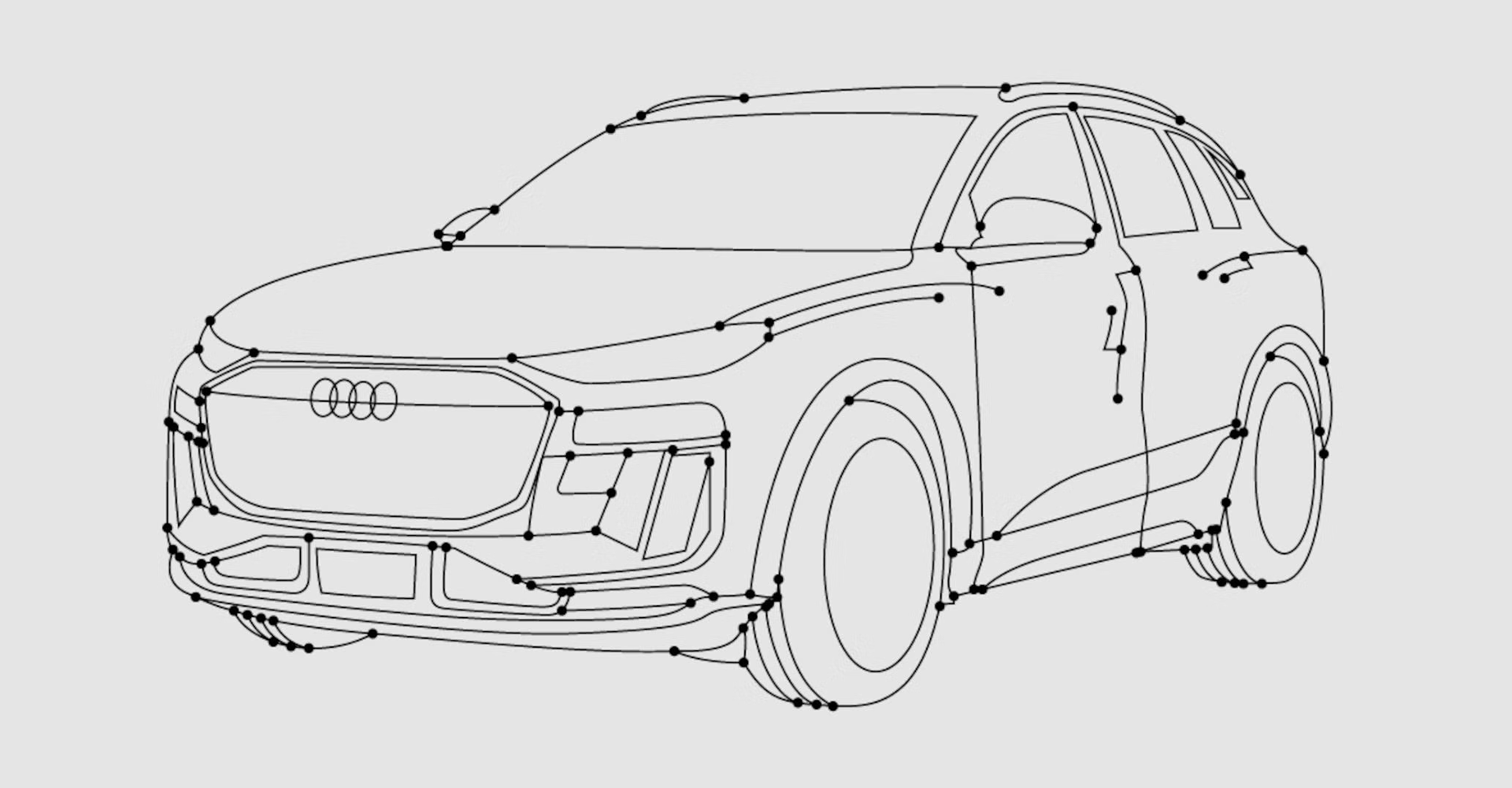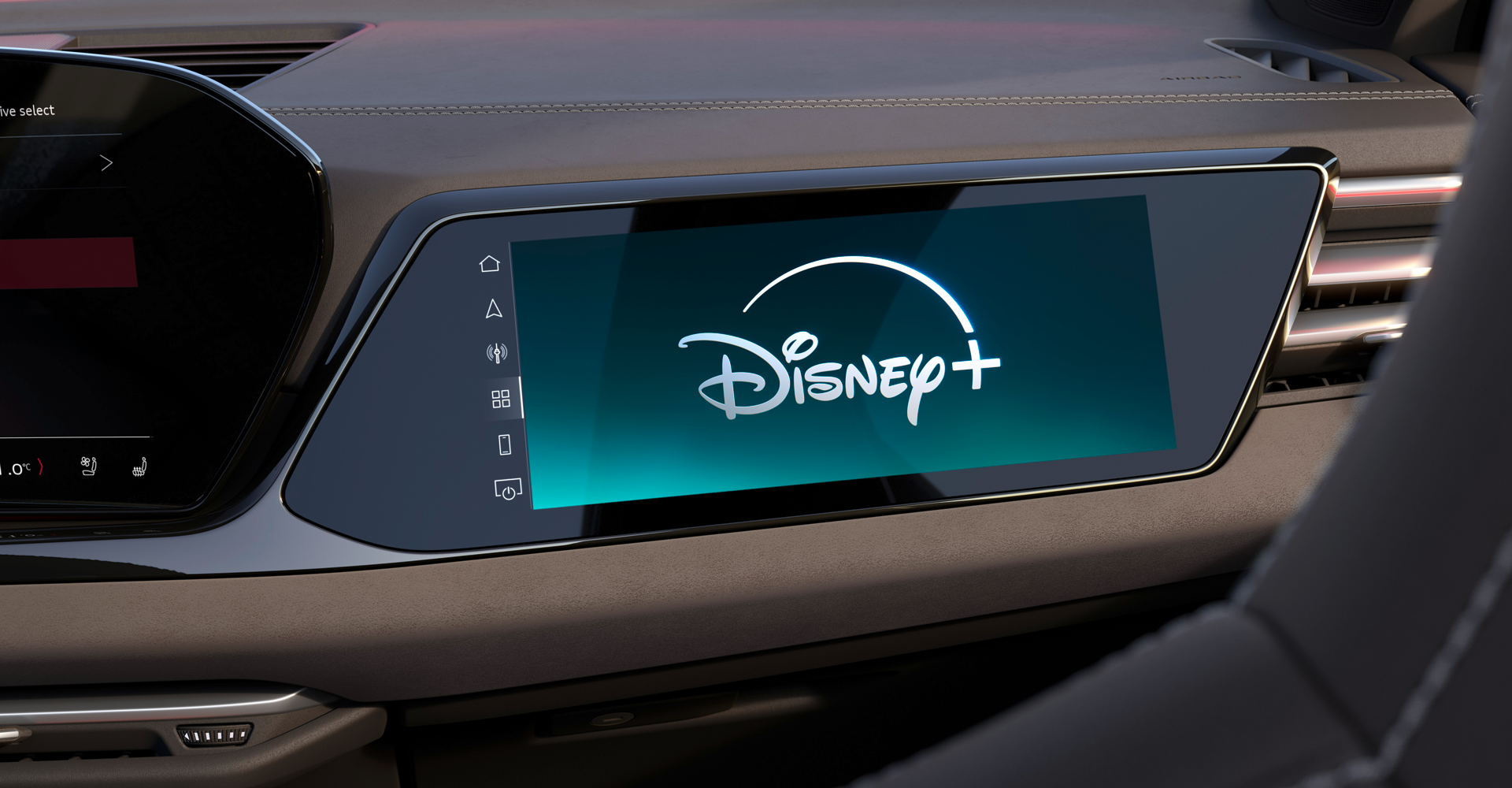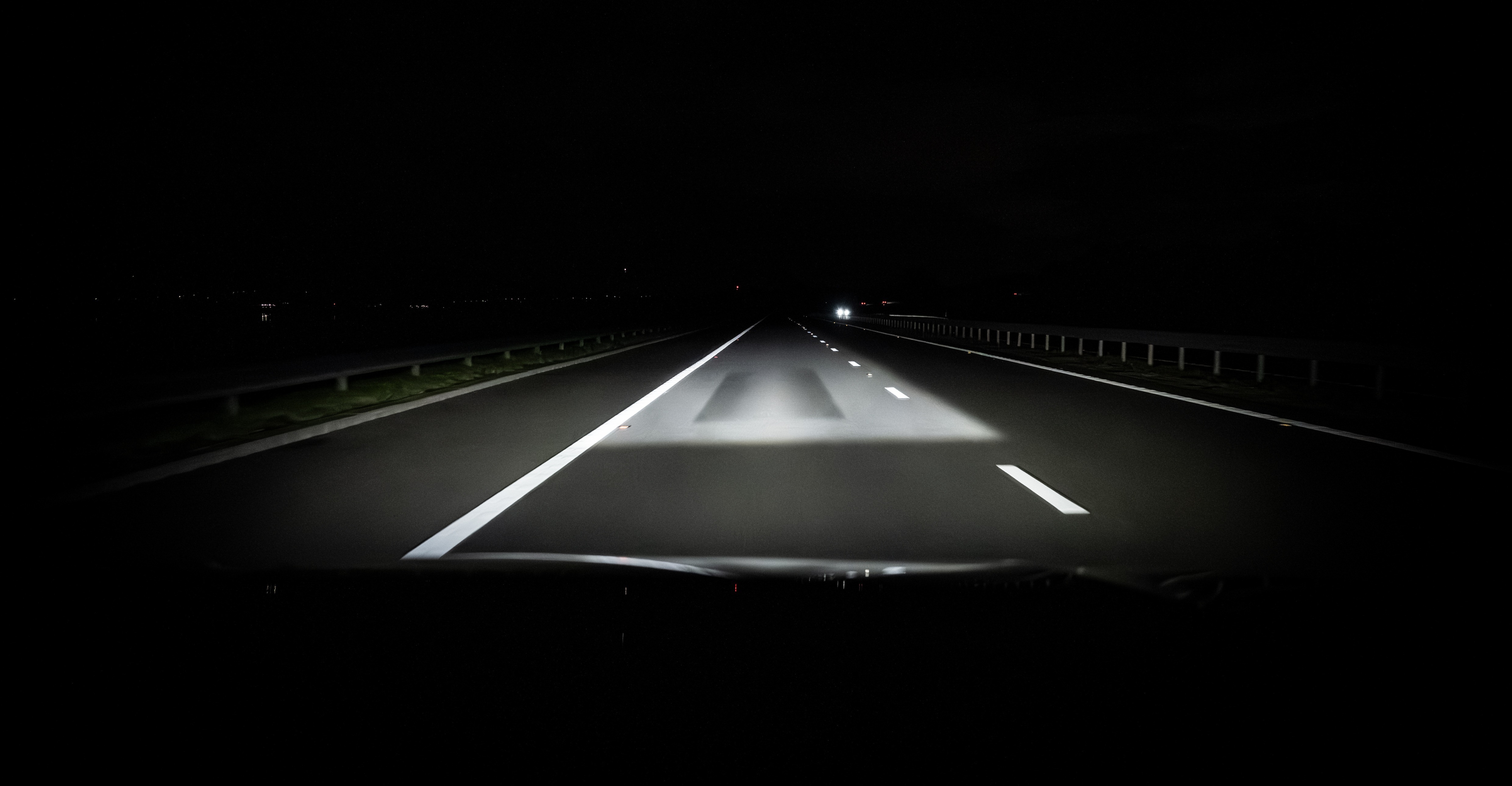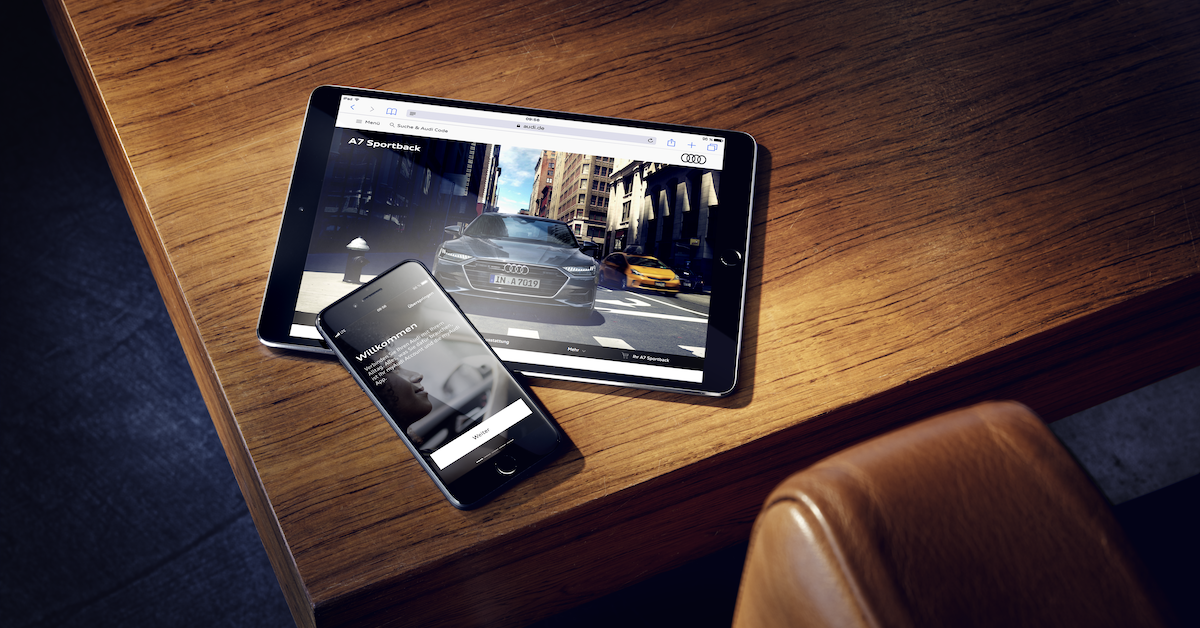inovacije 19.12.2025
- Domov
-
Modeli
-
Elektromobilnost
-
Svetovanje & nakup
-
Servis & dopolnilna oprema
-
Servis & dopolnilna oprema
- Pregled
- Servis
- Dopolnilna oprema
- Aktualno
-
- Rabljena vozila
-
Audi svet

Dinamični simulatorji vožnje bodo vplivali na Audije prihodnosti
Razvijanje, testiranje in izkušnja vožnje – preden jih pošljejo na ceste, inženirji v simulatorju vožnje preizkušajo vozne zmogljivosti novih Audijevih modelov. Enega od njih je preizkusil tudi Audijev pisec Alexander Stiehle. Ob tem se je neskončno zabaval, obenem pa še izvedel, kako simulator prihrani čas in denar v razvoju.
25.11.2020 Avtor: Alexander Stiehle Fotografije: Arhiv Audi
“We only create things that can become real in some form. The technology has to exist to make the concept feasible.”
The Pop.Up Next concept doesn’t herald a flying car per se, but a self-driving, self-flying, fully autonomous, electric-powered taxi. It’s designed to operate on a multi-mode principle. Two passengers sit in a capsule, which, for driving purposes, is attached to a four-wheel ground module that is also electric-powered and fully autonomous. For flight mode, the capsule is autonomously detached from the ground module, then attached to an eight-rotor air module or drone capable of vertical take-off.
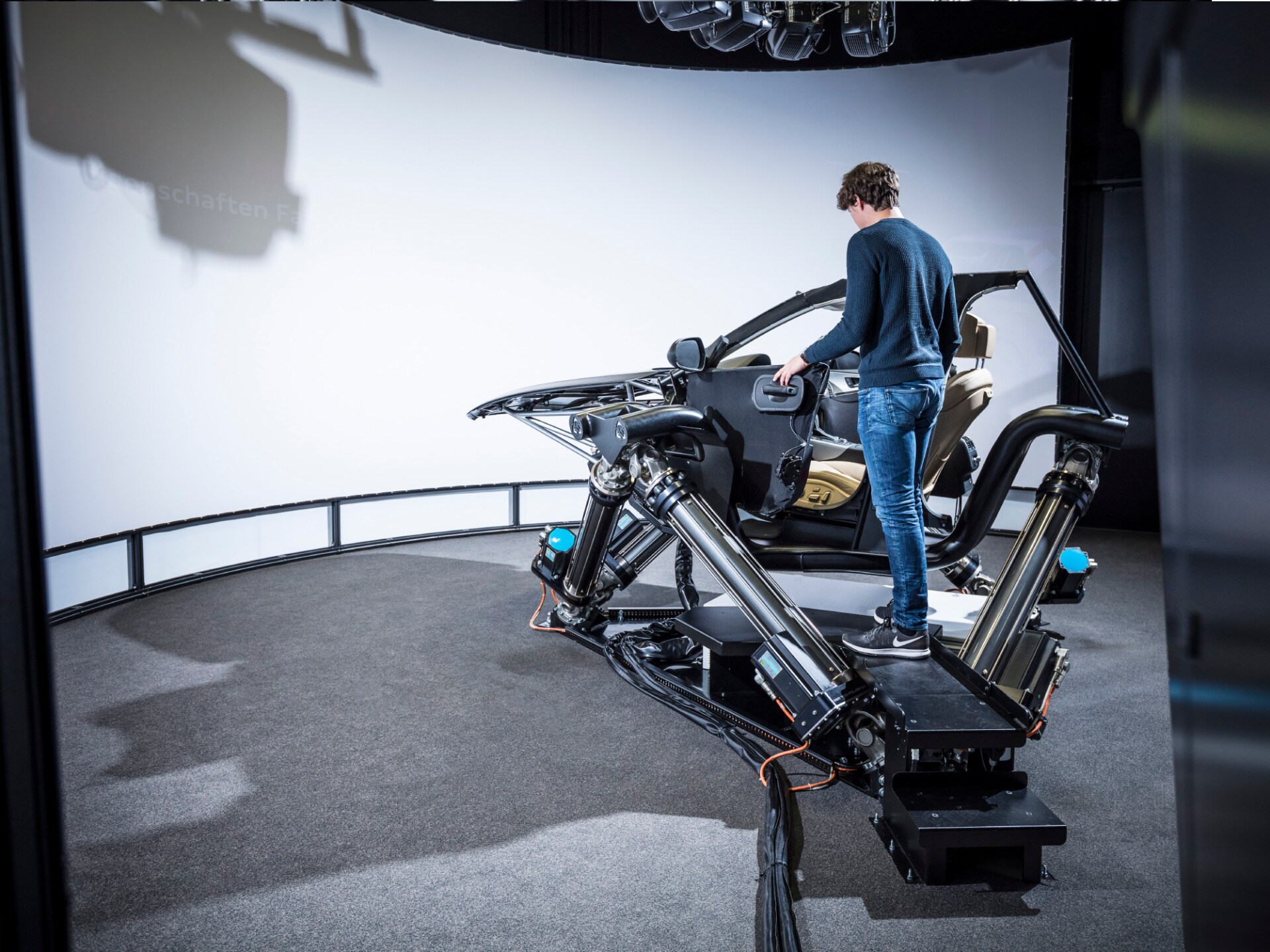
Minuta in 54 sekund – rezultat mojega prvega kroga v Audijevem simulatorju vožnje. Lahko bi šlo hitreje, si mislim. Stopalko za plin pritisnem do konca in motor zarohni. 220 konjskih moči me izstreli čez štartno črto dirkališča v Zandvoortu na Nizozemskem. Tik pred ostrim ovinkom imenovanim Tarzan sunkovito zavrem in zavijem na desno. Od visokega navora pri zavijanju se mi pričnejo tresti roke, a se ne vdam. Raje stisnem zobe …
Nenadoma se prižgejo luči. Dirkališče pred menoj začenja bledeti, dokler ga skoraj ne vidim več, in počasi se vrnem v resničnost. Nisem v Zandvoortu. Avto, v katerem sedim, ni pravi.
Audijev simulator vožnje: ko dirkališče postane digitalno
“Izčrpa te, kajne? Od tebe že kar kaplja.”
Ne, v prazni sobi sem in sedim v dinamičnem simulatorju vožnje v prostorih Audijevega oddelka za tehnični razvoj. Povsem iznenada se ob vratih mojega avta pojavi Richard Uhlmann, projektni vodja in razvojni inženir iz oddelka za razvoj podvozja.« »Izčrpa te, kajne? Od tebe že kar kaplja,« reče v smehu. Spravim se ven in si s hrbtno stranjo dlani s senc obrišem kaplje potu.
Prav ima. Čeprav ni resnično, te res izčrpa. Audijev simulator vožnje je edinstven. Posnemati skuša resničnost in to mu zelo dobro uspeva. Sestavljen je iz vozniške kabine, postavljene na heksapod (heksa – grško: šest, pod – grško: noga), in štiri metre visokega, 180 stopinjskega zaslona, ki stoji pred njo. Heksapodovih šest cilindrov na električni pogon simulatorju vožnje omogoča prosto in precizno premikanje po prostoru – do 60 centimetrov v vsako smer. Upor pri zavijanju simulira krmilna ročica, ki je nameščena pod volanom, sedem LED projektorjev pa na zaslon projicira sliko – na primer avtoceste ali dirkališča.
“quote”
Trust is key
Massimo Martinotti, head of mobility solutions, Italdesign

The journey is the reward
The company has already conducted a flight in public, at Drone Week in Amsterdam last year – but using a 1:4 scale model. The flight module accurately placed a passenger capsule on the ground module, which then drove from the test grounds autonomously. This proved the effectiveness of the Airbus coupling system and its locking and latching functionality. The air module currently rests on legs to make docking easier, but it’s envisaged that such legs would not be required by the time the concept reaches production.
To make the project with full-sized versions viable, more powerful batteries than those that exist today would be required, and Airbus is currently working on developing such technology. Noise is another issue, and reduction of the high-pitched whirring familiar to anyone who has witnessed even a small drone in flight is being sought. Italdesign is working with Audi to develop battery and electric-motor technology for the ground module – an area in which Audi’s engineers have already proven highly competent, as the recent launch of the e-tron SUV testifies. Therefor an Audi engineer is also based with the Italdesign team in Italy.
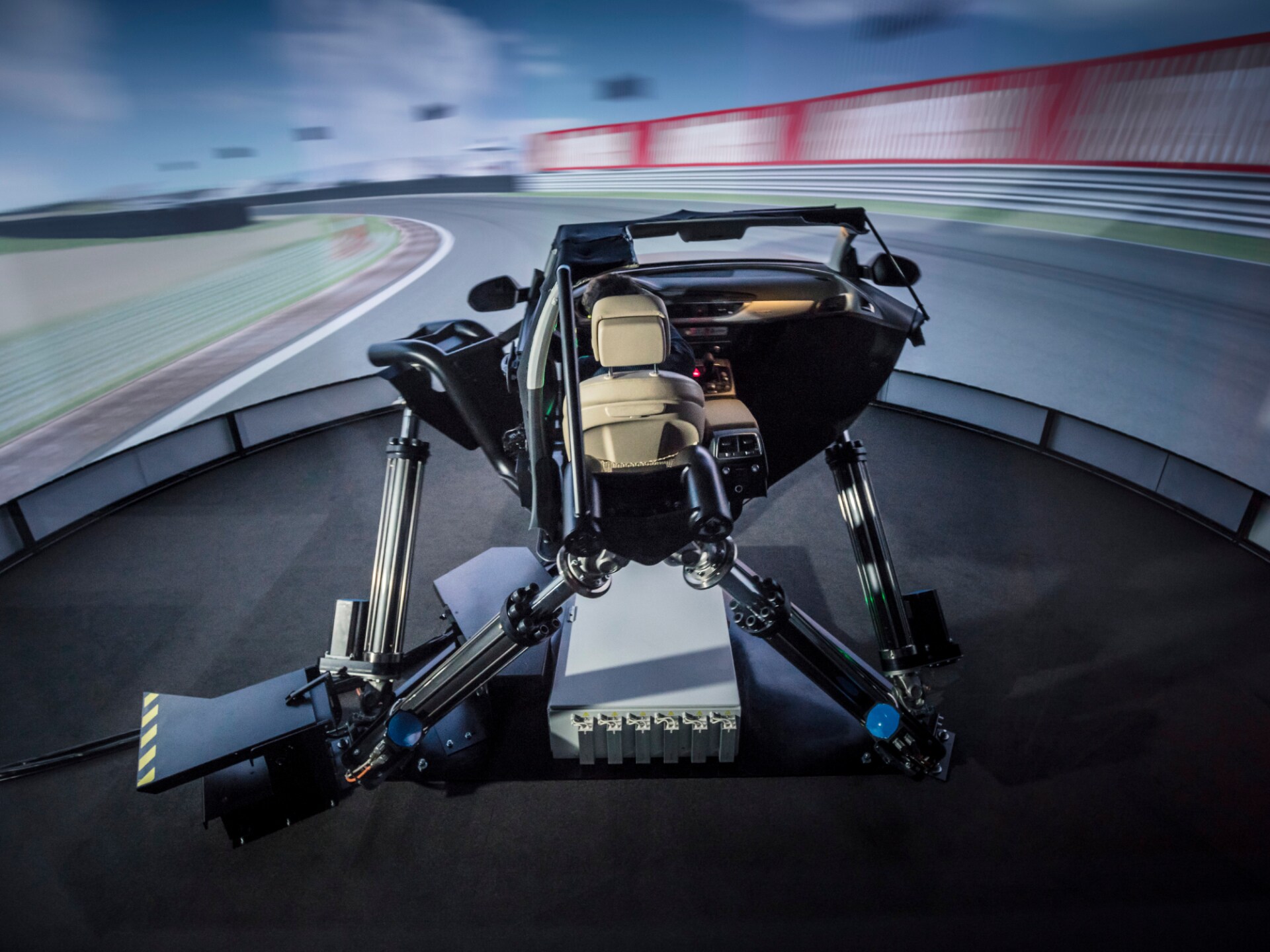
Napredno avtomobilsko testiranje: dolgotrajni razvoj se nam je obrestoval
»Ko zavijamo, se vozniška kabina premika na heksapodu, slika pa se samodejno prilagodi njenemu gibanju. To ustvarja vtis, da se dejansko voziš z avtomobilom,« pojasni Uhlmann, medtem ko sva zazrta v simulator vožnje. »Izkušnjo vožnje je treba reproducirati kar se da natančno, da voznik med premikanjem ne občuti slabosti. To smo imeli v mislih, ko smo v sodelovanju z doktorskim kandidatom razvili svoj lastni algoritem.« Soba je prepleskana s črno barvo, luči so med delovanjem simulatorja ugasnjene. Tako se ustvari najboljši možen kontrast za projekcijo na zaslonu.
Simulator vožnje smo začeli uporabljati pred kratkim, čeprav smo ga pričeli razvijati že leta 2012. Naši inženirji želijo ovrednotiti vozne lastnosti Audijevih modelov že od samega začetka razvojnega procesa, kar naredijo tako, da v simulator vnesejo vse relevantne podatke vozila, kot so teža, vzmetenje ali medosna razdalja. »Simulator vožnje je del celostne virtualne razvojne verige, ki jo že uspešno uporabljamo pri oblikovanju novih podvozij.«

The journey is the reward
The company has already conducted a flight in public, at Drone Week in Amsterdam last year – but using a 1:4 scale model. The flight module accurately placed a passenger capsule on the ground module, which then drove from the test grounds autonomously. This proved the effectiveness of the Airbus coupling system and its locking and latching functionality. The air module currently rests on legs to make docking easier, but it’s envisaged that such legs would not be required by the time the concept reaches production.
To make the project with full-sized versions viable, more powerful batteries than those that exist today would be required, and Airbus is currently working on developing such technology. Noise is another issue, and reduction of the high-pitched whirring familiar to anyone who has witnessed even a small drone in flight is being sought. Italdesign is working with Audi to develop battery and electric-motor technology for the ground module – an area in which Audi’s engineers have already proven highly competent, as the recent launch of the e-tron SUV testifies. Therefor an Audi engineer is also based with the Italdesign team in Italy.
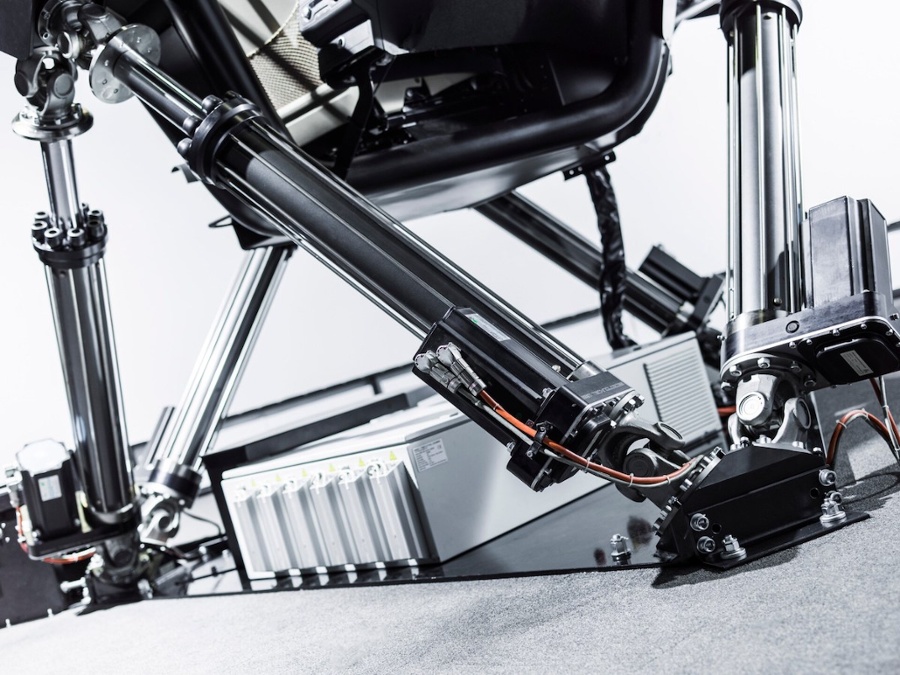
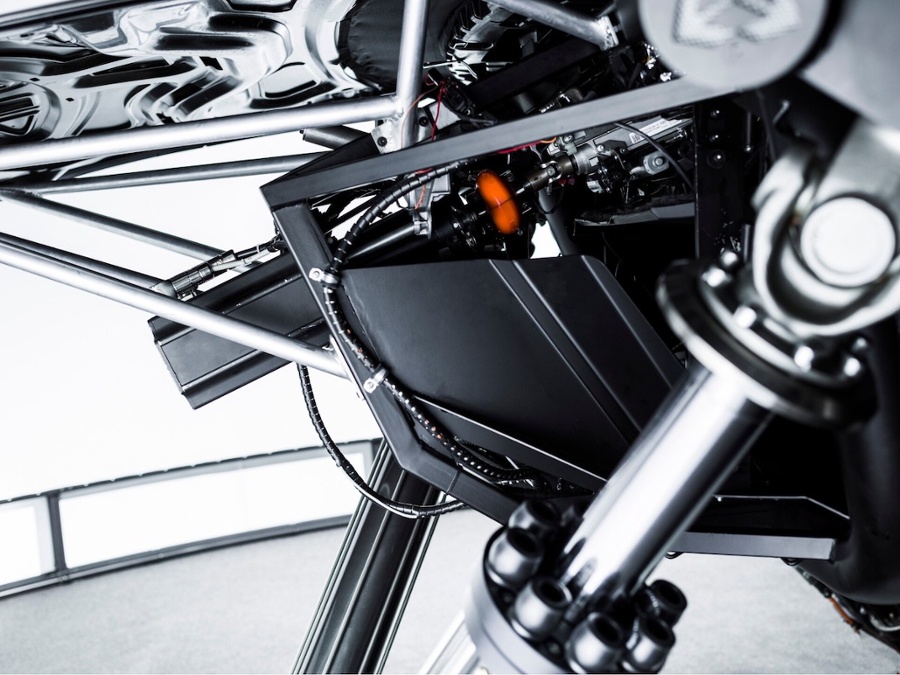
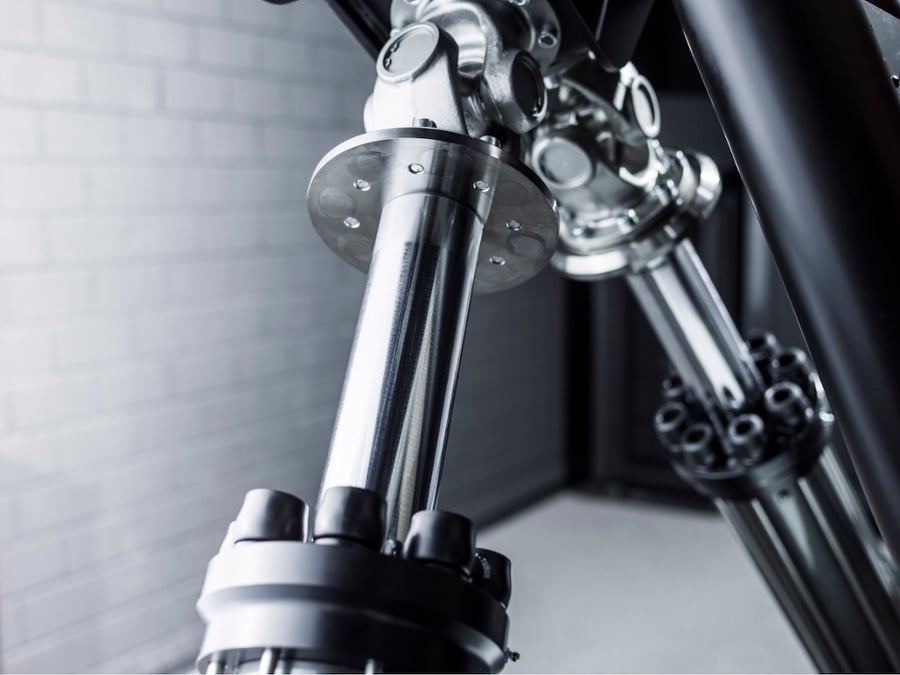

Še vedno obstajajo fizične omejitve: popolna simulacija vožnje se približa izvirniku
“Da bi ovrednotili dinamiko in udobnost vožnje, moramo še vedno uporabljati prava vozila.”
»Da bi ovrednotili dinamiko in udobnost vožnje, moramo še vedno uporabljati prava vozila, običajno drage prototipe. Tu nam bo v pomoč simulator vožnje. V prihodnosti bi ga radi že zelo zgodaj uporabili za preizkušanje voznih lastnosti in sprejemanje ključnih odločitev pri projektu. To bi nam prihranilo čas in sredstva, hkrati pa že zgodaj vplivalo na koncept vozila.« S pomočjo simulatorja lahko inženirji na primer sami občutijo, kako se obnašajo valji prototipa, in temu ustrezno prilagodijo koncept vozila.
Naj se 3D simulator vožnje zdi še tako resničen, ima kljub vsemu svoje omejitve.
Nekatere vzorce premikanja lahko reproduciramo samo delno, ali pa sploh ne. »Avtomobil ima pri hitrosti 60 km/h zavorno razdaljo približno 36-tih metrov. Če bi hoteli poustvariti zaviralni manever, bi morali med zaviranjem vozniško kabino prestaviti 36 metrov nazaj,« pove Uhlmann.
Rekordni čas v simulatorju vožnje: izziv sprejet
Ne glede na to pa lahko v simulatorju vožnje še vedno izgubiš nadzor nad vozilom. Če prehitro zapelješ v ovinek, bo zadek avta pričel drseti, slika se bo obrnila, simulator pa te bo pošteno stresel. To ustvari zelo realistično izkušnjo vožnje, čeprav so pospeški omejeni. Na moje vprašanje, kakšen je najboljši čas Zandvoorta, Uhlmann odgovori: »Sodelavec je krog odpeljal v minuti in 28-tih sekundah.« Spet se usedem za volan. Izziv sprejet.

The journey is the reward
The company has already conducted a flight in public, at Drone Week in Amsterdam last year – but using a 1:4 scale model. The flight module accurately placed a passenger capsule on the ground module, which then drove from the test grounds autonomously. This proved the effectiveness of the Airbus coupling system and its locking and latching functionality. The air module currently rests on legs to make docking easier, but it’s envisaged that such legs would not be required by the time the concept reaches production.
To make the project with full-sized versions viable, more powerful batteries than those that exist today would be required, and Airbus is currently working on developing such technology. Noise is another issue, and reduction of the high-pitched whirring familiar to anyone who has witnessed even a small drone in flight is being sought. Italdesign is working with Audi to develop battery and electric-motor technology for the ground module – an area in which Audi’s engineers have already proven highly competent, as the recent launch of the e-tron SUV testifies. Therefor an Audi engineer is also based with the Italdesign team in Italy.

The journey is the reward
The company has already conducted a flight in public, at Drone Week in Amsterdam last year – but using a 1:4 scale model. The flight module accurately placed a passenger capsule on the ground module, which then drove from the test grounds autonomously. This proved the effectiveness of the Airbus coupling system and its locking and latching functionality. The air module currently rests on legs to make docking easier, but it’s envisaged that such legs would not be required by the time the concept reaches production.
To make the project with full-sized versions viable, more powerful batteries than those that exist today would be required, and Airbus is currently working on developing such technology. Noise is another issue, and reduction of the high-pitched whirring familiar to anyone who has witnessed even a small drone in flight is being sought. Italdesign is working with Audi to develop battery and electric-motor technology for the ground module – an area in which Audi’s engineers have already proven highly competent, as the recent launch of the e-tron SUV testifies. Therefor an Audi engineer is also based with the Italdesign team in Italy.

The journey is the reward
The company has already conducted a flight in public, at Drone Week in Amsterdam last year – but using a 1:4 scale model. The flight module accurately placed a passenger capsule on the ground module, which then drove from the test grounds autonomously. This proved the effectiveness of the Airbus coupling system and its locking and latching functionality. The air module currently rests on legs to make docking easier, but it’s envisaged that such legs would not be required by the time the concept reaches production.
To make the project with full-sized versions viable, more powerful batteries than those that exist today would be required, and Airbus is currently working on developing such technology. Noise is another issue, and reduction of the high-pitched whirring familiar to anyone who has witnessed even a small drone in flight is being sought. Italdesign is working with Audi to develop battery and electric-motor technology for the ground module – an area in which Audi’s engineers have already proven highly competent, as the recent launch of the e-tron SUV testifies. Therefor an Audi engineer is also based with the Italdesign team in Italy.
“Quote”
